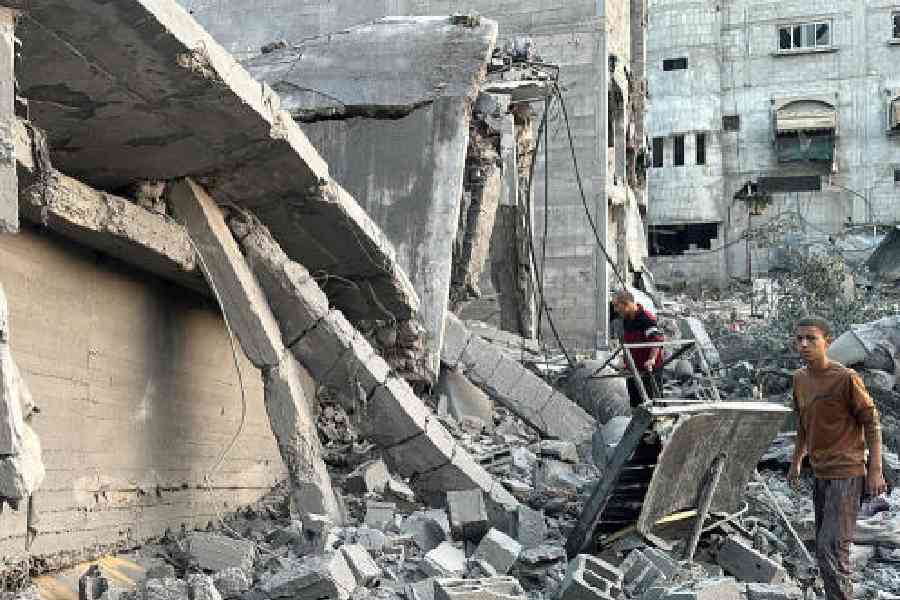Mariam Abu Amra’s six children panic when the sun goes down.
They are afraid of the dark, and ever since the war in Gaza began, their home is pitch-black by bedtime. The neighborhood outside is dark, too, illuminated only by cellphone screens that use up precious battery life.
The power has been out for more than one year in the Gaza Strip, and Gazans have had to make do with alternatives that fall far short of their basic needs.
“Every night is a struggle for us,” said Abu Amra, 36, who lives in Deir al Balah, in central Gaza. “Sometimes my children ask me when the electricity will be back again, but I have no answer.”
Electricity is a fundamental building block of modern life, and Gaza has had very little of it since Israel took measures to cut off its supply in the first days of the war in what it
said was an effort to weaken Hamas. That yearlong blackout undergirds almost every deprivation imposed by the war, and has turned bare necessities — from functioning medical equipment to bedroom night lights — into luxuries.
“I never knew how much all the people and the families here, including myself, relied on electricity,” said Abu Amra, who now cooks over a fire and does laundry by hand before the sun sets. “I have to wake up early now so I don’t miss a single minute of daylight.”
Before the war, years of conflict and an Israeli and Egyptian economic blockade imposed to weaken Hamas had left Gaza’s electrical grid able to provide only limited hours of power each day.
Cutting off Gaza’s access to Israeli electricity was one of the first things Israeli authorities did after the Hamas-led October 7 attack. Some Palestinians have been able to turn to generators or solar power, but Israel has severely restricted the ability to bring new solar panels, or the fuel to run generators, into the territory, arguing that Hamas has stockpiled fuel intended for civilians to use for rocket attacks.
Those measures have remained in place throughout the war, even where some of the territory’s few functioning power lines still connect Israel’s electric grid to critical Gazan infrastructure, including a major water desalination plant that sits idle.
“In some cases, the power lines are live, they just need to turn them on, and that is a political decision,” said Georgios Petropoulos, an official with the United Nations Office for the Coordination of Humanitarian Affairs in Gaza. “A lot of these issues are not technical or supply problems anymore, they are political issues.”
Since the start of the war, humanitarian groups have criticised the decision to cut off Gaza’s power. In response, Israel Katz, who served as energy minister at the time and was appointed defence minister this past week, implicitly put the blame on Hamas and other armed groups in Gaza for holding hostages abducted during their attack.
Israel has allowed some aid into Gaza after an international outcry, but last month, the Biden administration warned Israel that if it did not allow more humanitarian supplies into Gaza that could trigger a cutoff of American military aid.
The Coordinator of Government Activities in the Territories, the branch of Israel’s defence ministry that manages affairs in the West Bank and Gaza, said it “actively facilitates the entry and transport of fuel to humanitarian facilities, including hospitals, bakeries, and other essential infrastructure.” It said the military had permitted 30 million liters, or roughly eight million gallons, of fuel to enter Gaza since the war began, as well as 50 solar panels in the last few months. Israel’s energy ministry did not respond to requests for comment.
Aid groups say far more is needed to restore electricity and address the territory’s humanitarian crisis.
Unrepaired damage from repeated conflicts between Hamas and Israel had already left the enclave’s electrical infrastructure “in deplorable condition” even before the war began, according to a report by the Begin-Sadat Center for Strategic Studies, an Israeli think tank at Bar-Ilan University.
People in the territory got by under a cobbled-together system in which half of their electricity was generated in Israel and half in Gaza, according to the report. The power from Gaza came from a mix of sources, including a power plant fueled by diesel from Israel and Egypt, private generators also fueled by diesel, and solar panels on the roofs of homes and businesses.
So many used solar panels that Gaza had one of the world’s highest densities of rooftop solar systems, according to a report published in November 2023 by the Center for Strategic and International Studies, a think tank in Washington.
Those that have survived through the last year have been too small to power anything much larger than a cellphone, but they have nevertheless been a lifeline. Many of their owners have become wartime electricity vendors.
For Rasha Majed al-Attar, 20, the sun in Gaza has been “a blessing” amid the chaos around her in Deir al-Balah, where her family fled from Gaza City.
Several times a week, she walks to a nearby charging station and charges 10 phones from a solar panel. She said her family mostly uses them as night lights for their children who cry in the dark.
New York Times News Service











